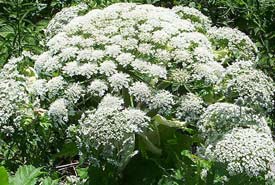Two harmful plants that can be found growing in Durham Region are giant hogweed and wild parsnip.
Giant Hogweed
An invasive perennial that spreads easily. It grows in moist areas along roadsides, ditches and streams and in open fields and woodlands.
Giant hogweed can grow to a height of 2 to 5 ½ metres. The plant has a thick, hollow stem that is covered in reddish-purple flecks and stiff hairs. The hairs are filled with a watery, clear sap. Sap can also be found in the stalks attached to the leaves, roots, seeds and flowers of the plant. The flowers are umbrella-shaped and white in colour.

Wild Parsnip
An invasive plant that is also known as poison parsnip. It spreads quickly in disturbed areas, such as abandoned yards, meadows, open fields and roadsides.
Wild parsnip can grow up to 1.5 metres. It has a single, green stem that can be up to 5cm thick. The stem is smooth with few hairs. The leaves, which have sharp toothed leaflets (shaped liked a mitten), are found in pairs. The flowers are umbrella-shaped and yellowish-green in colour.
Like giant hogweed and other members of the carrot family, it produces sap containing chemicals that can cause human skin to react to sunlight, resulting in intense burns, rashes or blisters.
What can happen if you come into contact with these plants?
The sap from these plants contain chemicals called furanocoumarins. These chemicals, when exposed to sunlight (UV radiation), cause a reaction known as phytophotodermatitis.
What does the reaction look like?
The initial reaction can occur within 15 minutes of being in the sun.
Redness and blisters can develop within 48 hours of exposure to sunlight. The severity of the reaction will depend on how long you remain in the sun.
The longer the sap remains on your skin the more sensitive the skin will be to the sunlight. Your skin can remain sensitive to the sun several months after exposure to giant hogweed.
What to do if you come into contact with giant hogweed?
- Wash the area with soap and cool water.
- Do not use warm water as this opens up pores and allows deeper penetration of the chemicals.
- Keep skin covered to protect it from sunlight.
- If you develop a rash or blisters seek medical attention. The treatment is dependent on how severe the reaction/burns are.
- Seek immediate medical attention if you get the sap in your eyes or you inhale sap particles.
